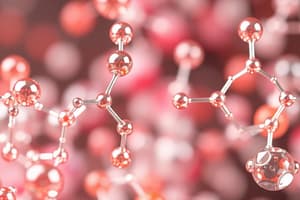Podcast
Questions and Answers
Explain the role of electronegativity in covalent bond formation, and how it differs from ionic bond formation.
Explain the role of electronegativity in covalent bond formation, and how it differs from ionic bond formation.
In covalent bonds, atoms share electrons to achieve stability. Electronegativity differences between atoms determine how equally electrons are shared. In ionic bonds, electrons are transferred due to large electronegativity differences.
Describe the difference between a cation and an anion, and explain how these ions contribute to the formation of an ionic compound.
Describe the difference between a cation and an anion, and explain how these ions contribute to the formation of an ionic compound.
A cation is a positively charged ion formed when an atom loses electrons, while an anion is a negatively charged ion formed when an atom gains electrons. These oppositely charged ions attract each other through electrostatic forces, forming a stable lattice structure in an ionic compound.
Explain how the arrangement of ions in a crystal lattice contributes to the high melting point and brittleness observed in ionic compounds.
Explain how the arrangement of ions in a crystal lattice contributes to the high melting point and brittleness observed in ionic compounds.
The crystal lattice structure of ionic compounds consists of alternating positive and negative ions held together by strong electrostatic forces. Breaking this lattice requires a significant amount of energy, resulting in a high melting point. The rigid arrangement also makes the compound brittle.
Describe the process by which ionic compounds dissolve in water, relating it to the polar nature of water molecules.
Describe the process by which ionic compounds dissolve in water, relating it to the polar nature of water molecules.
Explain why are polyatomic ions important in ionic compounds?
Explain why are polyatomic ions important in ionic compounds?
Describe what an ionic bond is, and explain how the law of conservation of mass relates to its formation.
Describe what an ionic bond is, and explain how the law of conservation of mass relates to its formation.
Outline the two main steps of how ionic compounds form?
Outline the two main steps of how ionic compounds form?
Explain what 'swap and drop' refers to in the context of writing ionic formulas.
Explain what 'swap and drop' refers to in the context of writing ionic formulas.
In the formation of Crystal Lattice, positive and negative ions alternate maxamizing ________. What is the missing word?
In the formation of Crystal Lattice, positive and negative ions alternate maxamizing ________. What is the missing word?
Describe the first step of why covalent bonds occur.
Describe the first step of why covalent bonds occur.
Flashcards
Polyatomic ions
Polyatomic ions
Groups of atoms that carry a charge and act as a single unit.
Ionic bond
Ionic bond
Electrostatic attraction between two atoms where one transfers electrons.
Ionic compound formation
Ionic compound formation
Metals transfer electrons to nonmetals, creating oppositely charged ions.
Electron transfer in ionic compounds
Electron transfer in ionic compounds
Signup and view all the flashcards
Crystal lattice formation
Crystal lattice formation
Signup and view all the flashcards
Physical properties of ionic compounds
Physical properties of ionic compounds
Signup and view all the flashcards
Covalent bonding
Covalent bonding
Signup and view all the flashcards
Covalent bond occurrence
Covalent bond occurrence
Signup and view all the flashcards
Study Notes
Polyatomic Ions
- These are groups of atoms that carry a charge and act as a single unit ionic.
- Common examples include ammonium, hydroxide, nitrate, carbonate, and sulfate.
Steps to Write Ionic Formulas (Polyatomic)
- Identify the cation and anion.
- Balance the total charge using subscripts. For example, Na+ NO3-.
- Use brackets if there is more than one polyatomic ion. For example, Mg+2 OH- → Mg(OH)2.
- Write out the balanced formula.
- Use the "swap and drop and balance" technique.
Ionic Bond
- An ionic bond arises from the electrostatic attraction between two atoms.
- It involves the transfer of electrons from one atom to another.
- During the transfer, the law of conservation of mass applies.
Formation, Structure, and Properties of Ionic Compounds
- Ionic compounds form through ionic bonding.
- Metals transfer electrons to nonmetals, creating oppositely charged cations and anions.
- These ions are held together by electrostatic attraction.
- This forms a strong, stable lattice structure.
How Ionic Compounds Form
- Requires electron transfer.
- Metals lose electrons, forming cations.
- Nonmetals gain electrons, forming anions.
- The aim is to achieve a full outer shell for stability.
- Formation of crystal lattice:
- Positive and negative ions alternate, maximizing attraction.
- Each ion is surrounded by oppositely charged ions, forming a strong, rigid structure.
Impact of Ionic Bonds on Physical Properties
- High melting point, such as water at 801°C, due to strong electrostatic attraction.
- This bond requires significant energy to break.
- Ionic compounds tend to be brittle.
- Water's polarity means it dissolves ionic compounds because it has partial charges.
- Individual ions separate during dissolution (dissociation).
Covalent Bonding
- Covalent bonding occurs when two nonmetals share electrons.
- This allows them to achieve a stable electronic configuration.
Occurrence of Covalent Bonds
- Involves electron sharing between nonmetals.
- Nonmetals have high electronegativity.
- Atoms attract electrons strongly.
- Atoms share the orbitals overlap.
Studying That Suits You
Use AI to generate personalized quizzes and flashcards to suit your learning preferences.




